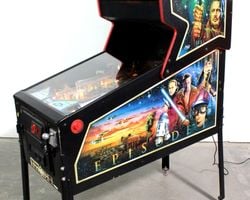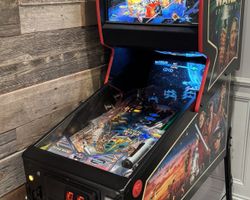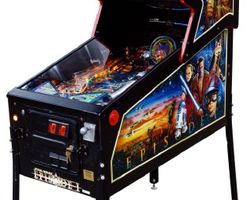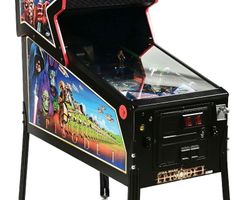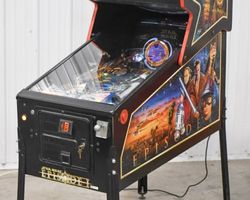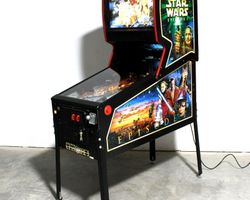Star Wars Episode I
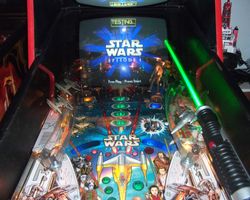
Average Prices: USD $1,600 to $3,400
Produced: June, 1999
Production Run: 3,525 units
Machine Type: Solid State Electronic
MPU: Williams Pinball 2000
Players: 4
Concept by: John Popadiuk
Design by: John Popadiuk
Art by: Kevin OConnor, Paul Barker, Dave Mueller
Dots/Animation by: Alan Cruz
Mechanics by: Jack Skalon, Bob Brown
Music by: Eric Pryzby
Sound by: Eric Pryzby
Software by: Cameron Silver, Duncan Brown
Williams Pinball’s Star Wars Episode I, released in June 1999, stands as a pivotal machine in pinball history, not solely for its association with the globally recognized franchise, but also as a testament to innovation during a period of significant change for its manufacturer. This machine emerged from the innovative Pinball 2000 platform, a bold endeavor by Williams Electronic Games, Inc. to revitalize the pinball industry by integrating a video monitor directly into the playfield. It was the second title to utilize this groundbreaking technology, following Bally's Revenge From Mars.
The creation of Star Wars Episode I was spearheaded by designer John Popadiuk, who also contributed to its core concept. The visual landscape of the game was brought to life by artists Dave Mueller, Kevin O'Connor, and Paul Barker, with Eric Pryzby crafting the distinct soundscape and musical compositions. Software development was managed by Cameron Silver and Duncan Brown, while Alan Cruz handled the animations that played a central role in the game’s interactive experience. Mechanical engineering was overseen by Bob Brown and Jack Skalon, ensuring the physical elements worked in concert with the digital.
Its release in June 1999 was followed by a production run of 3,525 units. This machine holds a unique place as the final pinball title manufactured by WMS Industries, encompassing both Williams and Bally labels, before the company announced its exit from pinball production on October 25, 1999. An intriguing piece of trivia ties directly to this closure: the scoring for spelling "Jar Jar" in the software version 1.4 awarded 19,992,510 points, a clear numerical nod to the date of WMS's withdrawal from the pinball market (25-10-1999). Furthermore, one of the animators, Kevin O'Connor, personally performed as the Darth Maul character in the video sequences, undergoing stick-fighting training for the green-screen filming. Some of the final cabinet units produced featured special plaques, with some indicating sequential numbering up to 5100, and others marking "The Final Collector's Series of 100," intended to signify their commemorative status as the last productions. A singular gold cabinet was also produced, distinguishable by its unique serial number and golden laminate.
Signature Features and Design
The defining characteristic of Star Wars Episode I is its integration of the Pinball 2000 platform, centered around an interactive video monitor positioned at the rear of the playfield. This monitor projects holographic images that appear to interact with the physical ball, blurring the line between digital and mechanical gameplay. This feature was designed to offer a "virtual reality" experience, transforming traditional pinball into something more dynamic and visually engaging.
Beyond the innovative display, the machine featured action buttons on the cabinet, allowing players to fire laser shots on the screen, directly affecting on-screen characters and targets. A strategically placed magnet on the playfield further enhanced this interactivity, influencing ball movement in conjunction with video events. The cabinet itself was designed with a modular approach, making it "kit-able" and theoretically allowing operators to convert the base cabinet and CPU to other Pinball 2000 titles, though this concept was never fully realized due to the platform's short lifespan. The artwork, a vibrant interpretation of the film's aesthetic, adorned the playfield and cabinet, featuring characters and iconic elements from Star Wars: Episode I. Physical toys on the playfield, such as models of Trade Federation Fighters and various action figures, including Jar Jar Binks, anchored the digital experience within the physical space.
Playfield and Mechanics
The playfield of Star Wars Episode I presents a layout designed to facilitate interaction with the integrated video screen. It features two prominent ramps and three jet bumpers, standard elements in many pinball designs. Two main flippers at the bottom of the playfield control ball propulsion, with a manual plunger for launching. The playfield also incorporates two drop targets and two captive balls, providing distinct physical targets for players to aim for. The singular magnet plays a role in various modes, often manipulating the ball's trajectory in conjunction with on-screen events.
The design philosophy behind the layout aimed to create a seamless interplay between physical shots and the digital realm. Shots are not merely about hitting targets for points; they often trigger animations, activate characters on the screen, or initiate video modes where the ball's movement dictates on-screen actions. For instance, hitting a physical target might cause an enemy on the video screen to appear or be damaged, requiring further physical shots to defeat them. This fusion of physical and digital elements sought to immerse the player deeply into the Star Wars narrative. The artwork on the playfield, executed by Dave Mueller, Kevin O'Connor, and Paul Barker, employed a color palette and visual style directly inspired by the movie, enhancing the thematic immersion. Early prototype playfields notably featured pink outlines around some artwork elements and specific color variations, such as Anakin's yellow hair, which were later changed to yellow outlines and different hues in the production models.
Gameplay Dynamics
Gameplay in Star Wars Episode I is characterized by its heavy reliance on the interactive hologram video mode, which occupies more than half of the machine's action. The core objective often revolves around physical shots translating into actions on the screen, such as engaging in lightsaber duels, participating in podraces, or battling Trade Federation droids. The two action buttons on the cabinet allow players to fire lasers, which are often crucial for defeating on-screen enemies or progressing through specific modes.
The scoring system and progression are built around completing various objectives tied to the movie's plot. The game features three-ball multiball, offering high-scoring opportunities. Unique modes, such as those involving Jar Jar Binks, require specific shot sequences to advance. For example, some modes might involve hitting specific targets to collect "gungan energy" or evade onscreen obstacles. Player strategies often involve mastering the timing of physical shots to align with video events, effectively "hitting" on-screen targets with the physical ball. Defeating the various on-screen antagonists and progressing through the storyline missions are primary objectives. While the integration of video was innovative, some gameplay elements, such as specific missions or character interactions, could become repetitive over extended play sessions.
Reception and Legacy
Star Wars Episode I received a mixed reception within the pinball community, a reflection of its ambitious departure from traditional pinball design and its association with a divisive film. Players generally lauded the innovative Pinball 2000 technology, appreciating the novelty of the integrated video screen and the unique "VR" sensation it offered. Many recognized the effectiveness of the theme integration, with the machine’s visuals, music, and sound effects successfully evoking the Star Wars universe. The sound system, in particular, was often highlighted for its quality, enhancing the immersive experience. The cabinet design and artwork were also frequently praised for their unique appearance, despite some finding the digital art somewhat dated over time. For casual players and fans of the Star Wars franchise, the game often proved engaging and accessible.
However, the machine faced significant criticism. A common complaint revolved around the perceived repetitiveness of shots and modes, leading to a sense of limited depth for experienced players. The playfield, while functional, was sometimes characterized as plain, small, or dark, lacking the intricate layouts found in some other machines. The inclusion of the character Jar Jar Binks and his associated modes drew considerable ire from many players. Some felt the ruleset was "unfinished" or lacked the complexity that would provide lasting challenge. Technical issues, particularly concerning the monitor, were also reported by some operators and owners. Furthermore, the game suffered from its thematic tie to Star Wars: Episode I, a film that did not resonate positively with all Star Wars enthusiasts. Comparisons to Revenge From Mars, the other Pinball 2000 title, were frequent, with many players expressing a preference for the earlier machine.
Despite the mixed feedback, Star Wars Episode I holds an undeniable place in pinball history as the very last machine produced by Williams. It represented the final attempt by a pioneering company to redefine pinball, demonstrating the potential of integrating advanced digital elements with physical gameplay. Although the Pinball 2000 platform's full potential was never realized due to Williams’s closure, Star Wars Episode I stands as a testament to innovation, a unique experiment that blended two distinct forms of entertainment into one interactive experience.
Sponsored Links
 Ebay Listings
Ebay Listings
 Auction Results
Auction Results
| Cost | Location | Date |
|---|---|---|
| USD $1,900 |  Maryland, United States Maryland, United States |
09 October, 2025 |
| USD $4,450 |  Illinois, United States Illinois, United States |
24 June, 2025 |
| USD $3,999 |  Virginia, United States Virginia, United States |
23 April, 2025 |
| USD $2,800 |  Colorado, United States Colorado, United States |
07 April, 2025 |
| USD $3,000 |  Nevada, United States Nevada, United States |
05 December, 2024 |
| USD $6,499 |  California, United States California, United States |
25 November, 2024 |
| USD $3,400 |  United States United States |
21 October, 2024 |
| GBP £3,495 |  United Kingdom United Kingdom |
27 September, 2024 |
| USD $3,000 |  Illinois, United States Illinois, United States |
19 July, 2024 |
| USD $1,300 |  Maryland, United States Maryland, United States |
28 June, 2024 |


Private Policy · Search Website · Contact Us
As an eBay Partner, we may earn a commission from qualifying purchases made through links on this site, at no additional cost to you.
All trademarks and copyrighted materials remain property of their respective owners. All other content copyright 2007 - 2025 Pinpedia.

